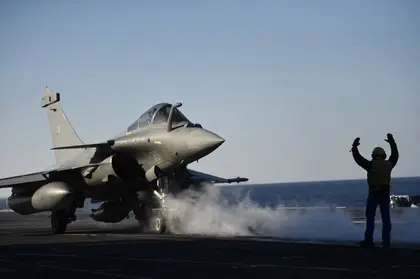Serbia is in negotiations with France to purchase a dozen Rafale fighter jets for $3 billion in a bid to diversify its armaments.
The new 4.5-generation multirole fighters are expected to replace Belgrade’s aging Soviet MiG-29 fleet, indicating a significant shift in its diplomatic stance as the deal would entail long-term commitments with the West that require training and logistic support from France.
JOIN US ON TELEGRAM
Follow our coverage of the war on the @Kyivpost_official.
Serbian President Aleksandar Vučić said Belgrade is expected to sign the contract in the next two months with French President Emmanuel Macron present, following a meeting with the latter in Paris last week.
“We are determined to buy new aircraft that would significantly improve our combat capabilities,” Vučić said.
An unnamed Serbian defense official called the purchase a “milestone” and told the Financial Times (FT) that the war in Ukraine “has hastened diversification” for the Balkan nation, and “geopolitical circumstances” have steered Belgrade’s armament procurement closer to the West. He noted that Serbia had also bought French radar and missile systems and placed orders for Airbus transport planes.
“We have relied on Soviet-type technology, and we have some long tails, a need to maintain that equipment. Due to geopolitical circumstances now it is not even feasible – even if you wish – to buy from Russia anyway,” said the official.

‘We Don’t Have Time to Wait Until Spring’ – Ukraine at War Update for Nov. 12
The official added that the Rafale deal is “negotiated more than 90 percent,” with Paris and Belgrade agreeing on the financial terms.
Retired Serbian Air Force General Sreto Malinović told FT that Belgrade also needed aircraft radars and associated attack-navigation equipment as part of the deal to complete the package.
“It is very important that air-to-air missiles, which will ensure control of the airspace, go in the set with the planes,” said Malinović.
Serbia, formerly a part of Yugoslavia, had been the Kremlin’s close ally in the Balkans in recent years, where Belgrade received six MiG-29 fighters from Moscow in 2018, just four years before Russia’s full-scale invasion of Ukraine.
While Yugoslav strongman Josip Broz Tito has been a pioneer in the non-aligned movement, siding neither with the West nor the Soviets during the Cold War, the collapse of Yugoslavia marked a departure from Tito’s policy and saw Serbia rekindling its tie with Moscow due to political, historical and cultural connections.
Belgrade’s cultural ties with Moscow could be traced back to Pan-Slavism at the turn of the 20th century, while their modern political ties could be attributed to Belgrade’s resentment of NATO, which intervened in the Kosovo War on Kosovo’s behalf and conducted airstrikes on Belgrade.
However, the Rafale purchase is the latest in a series of indications that Belgrade might be distancing itself from Moscow and orienting itself toward the West.
While the Balkan nation has not introduced sanctions on Russia as per the West’s suggestion, with Vučić publicly reiterating that “a friend in need is a friend indeed” this year while describing Belgrade’s ties with Moscow, its aspiration to join the EU has led to it publicly denouncing Russia’s war in Ukraine and supporting Ukraine’s sovereignty over Donbas and Crimea.
In March 2022, soon after Russia launched its full-scale invasion of Ukraine, Serbia was also one of the nations that voted to condemn the invasion in a UN resolution.
You can also highlight the text and press Ctrl + Enter






